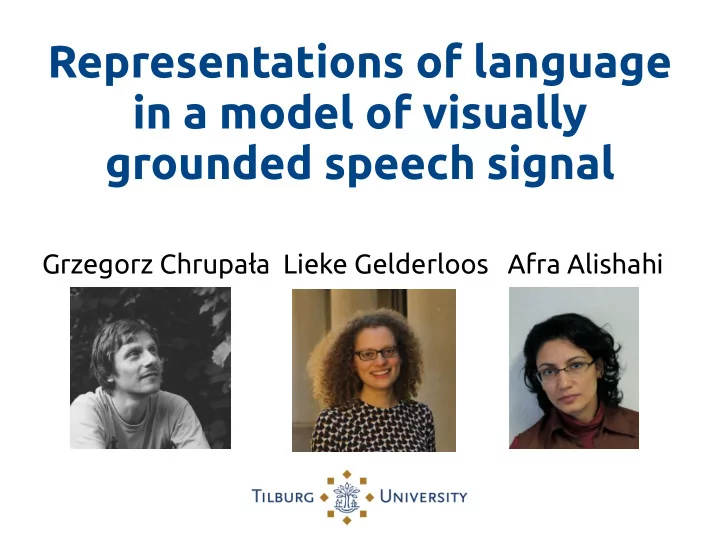

Representations of language in a model of visually grounded speech signal Grzegorz Chrupała Lieke Gelderloos Afra Alishahi
Automatic Speech Recognition A major commercial success story in Language Technology
Very heavy-handed supervision I can see you
Grounded speech perception
Data Flickr8K Audio (Harwath & Glass 2015) 8K images, fjve audio captions each MS COCO Synthetic Spoken Captions 300K images, fjve synthetically spoken captions each
Project speech and image to joint space a bird walks on a beam bears play in water
Image model Pre-classifcation layer BOAT BIRD BOAR
Speech model Input: MFCC Subsampling CNN Recurrent Highway Network (Zilly et al 2016) Attention
Model settings
Image retrieval Flickr8K MSCOCO Newer CNN architecture: Harwath et al 2016 (NIPS), Harwath and Glass 2017 (ACL)
Levels of representation What aspects of sentences are encoded? Which layers encode form, which encode meaning? Auxiliary tasks (Adi et al 2017)
Form-related aspects Use activation vectors to decode Utterance length in words Presence of specifjc words
Number of words Input Activations for utterance Model Linear regression
Word presence Input Activations for utterance MFCC for word Model MLP
Semantic aspects
Representational Similarity Correlations between sets of pairwise similarities according to Activations AND Edit ops on written sentences Human judgments (SICK dataset)
Homonym disambiguation
Follow-up work Afra Alishahi, Marie Barking and Grzegorz Chrupała. Encoding of phonology in a recurrent neural model of grounded speech Friday, session #4 at CoNLL
Conclusion Encodings of form and meaning emerge and evolve in hidden layers of stacked RHN listening to grounded speech Code: github.com/gchrupala/visually-grounded-speech Data: doi.org/10.5281/zenodo.400926
Error analysis Text usually better Speech better: a yellow and white birtd is in flight Long descriptions Misspellings Speech Text
Length
Text model Convolution → word embedding No attention
Recommend
More recommend